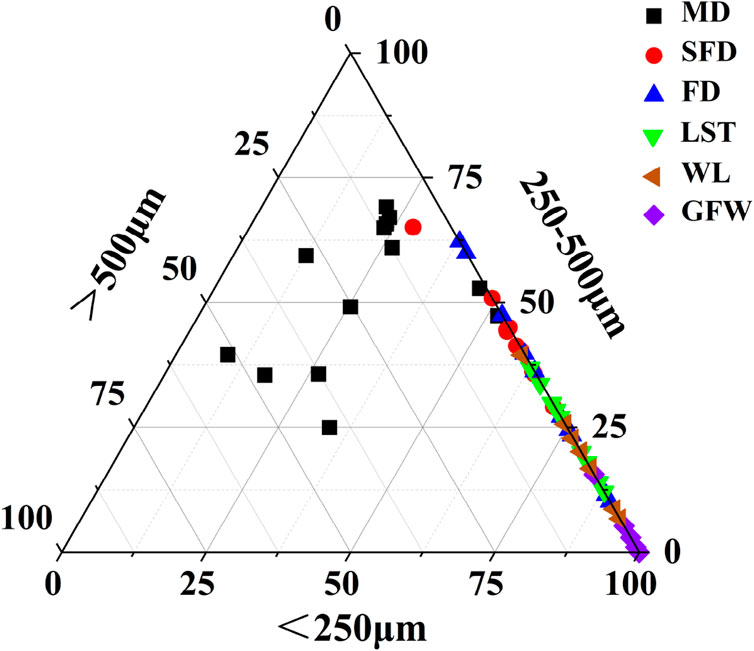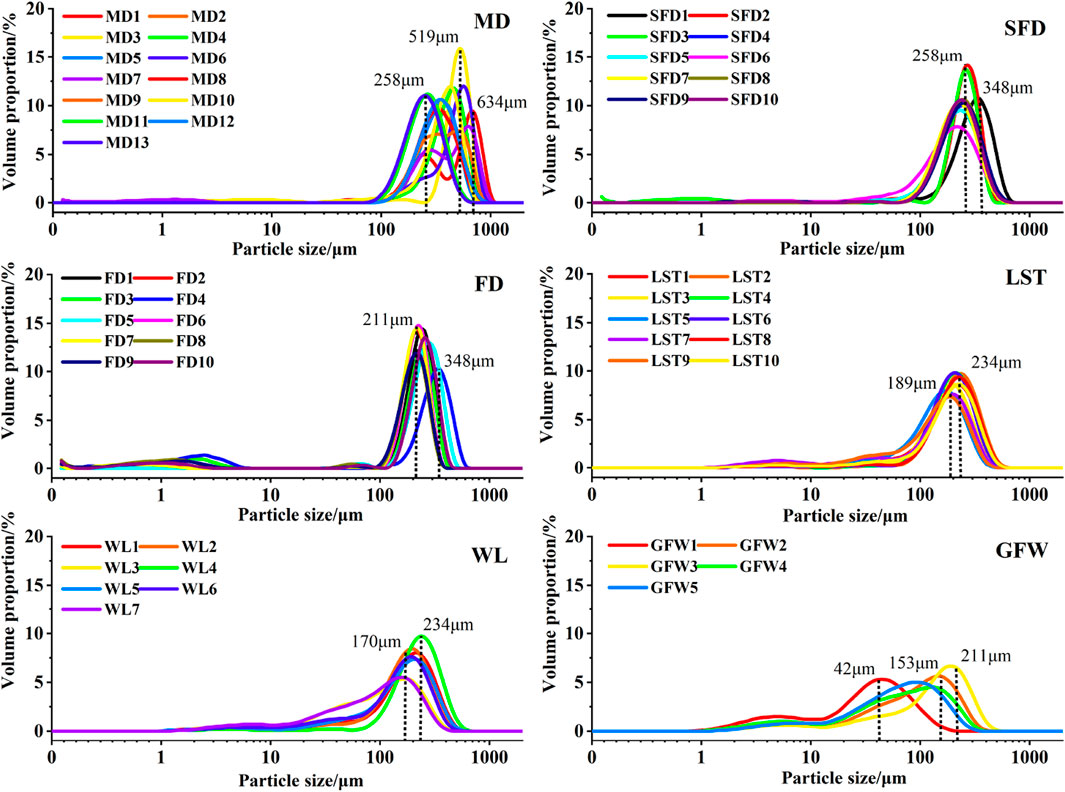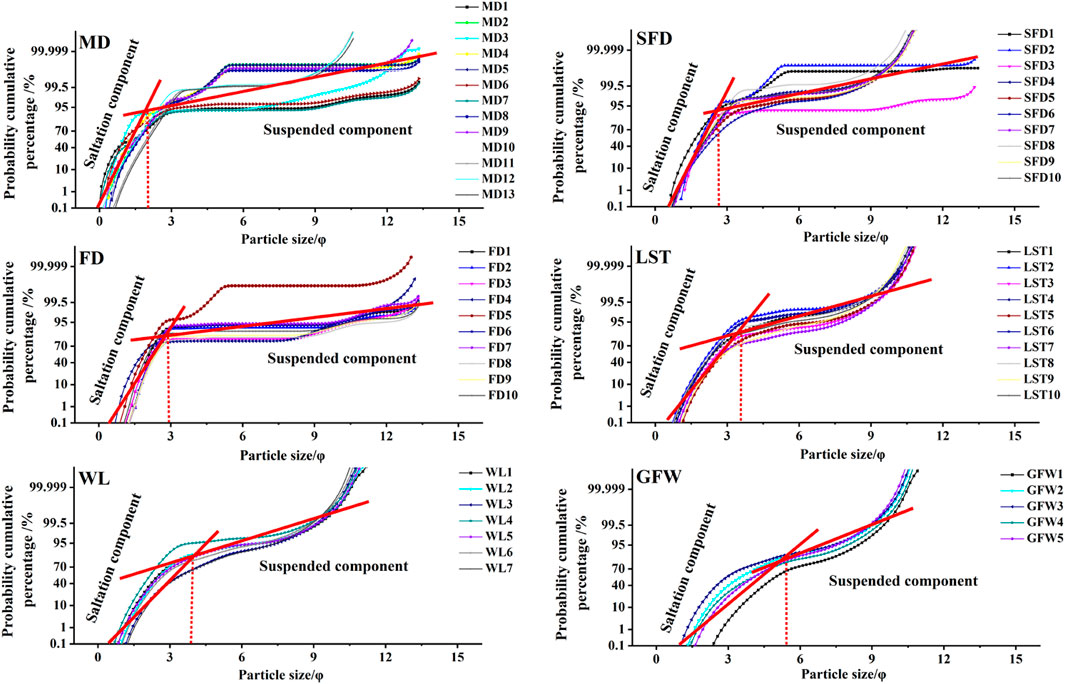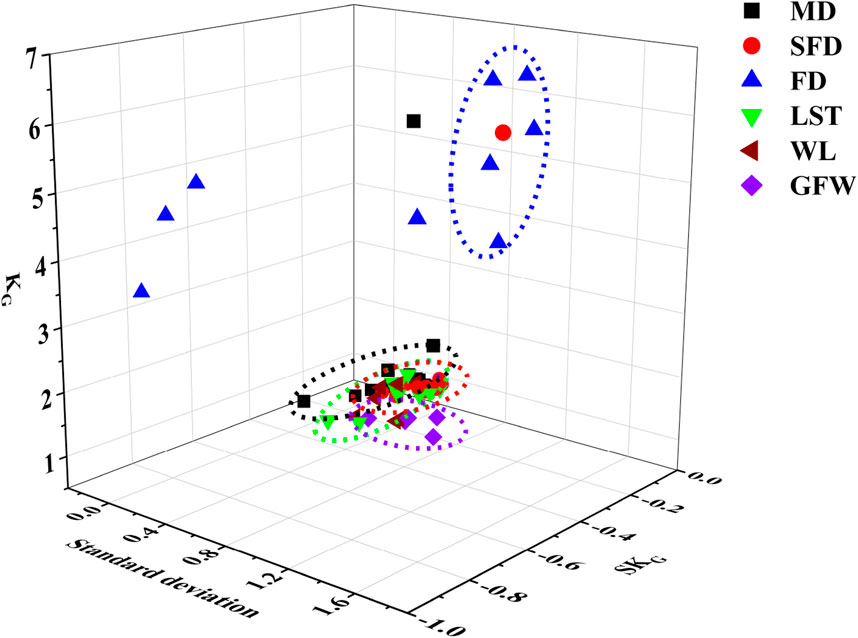- 1Inner Mongolia Key Laboratory of Aeolian Physics and Desertification Control Engineering, College of Desert Control Science and Engineering, Inner Mongolia Agricultural University, Hohhot, Inner Mongolia Autonomous Region, China
- 2Hanggin Desert Ecosystem Positioning Research Station, Inner Mongolia Agricultural University, Hohhot, China
Sediment grain size characterization is one of the main components of aeolian geomorphology research. Sand particle size can determine the basic form of sand movement. The distribution and form of grain size parameters of different types of sediments were calculated using six surface types of sediments around Qixing Lake in the Kubuqi Desert: Mobile dune Semi-fixed dune Fixed dune Lakeshore terrace Wetland and Grassy flat wetland The results showed that the surface sediments were mainly composed of medium sand and fine sand, and all types were negatively skewed. The differentiation pattern of the saltation component and suspended component of the surface sediment is characterized by a two-stage pattern. The percentage contribution of suspended components in lakeshore terraces, wetlands, and Grassy flat wetlands (total average 21.07%) is more than twice that of mobile dunes, semifixed dunes, and fixed dunes (total average 9.47%). This suggests that mobile dunes, semi-fixed dunes, and fixed dunes are not the main contributing surface type of suspended material in the Qixing Lake area.
1 Highlights
The movement of suspended material in the surface sediments of Qixing Lake promotes the particle size parameter to become negatively skewed.
Typical sand dunes (mobile, semi-fixed, and fixed dunes) are not the main contributing surface type for the generation of suspended material in the Qixing Lake area of the Kubuqi Desert.
2 Introduction
Sediment is the material basis for the formation and development of wind-sand landforms. Sediment grain size characterization is one of the important contents of wind-sand scientific research, which can reflect the formation and evolution of wind-sand landforms, soil wind erosion, dust storms, and desertification processes (Li et al., 2019), and it is crucial in identifying the depositional environment of a region, as well as judging the mode of particle transport and dynamic conditions (Song et al., 2022). Currently, research on desert sediments at the landscape scale are mostly focused on the stability of typical dune surfaces (Zhou et al., 2021), sediment discrimination (Karimi et al., 2017), construction and ecological restoration of vegetation in sandy areas (Han et al., 2022), and wind-sand movement (Telfer et al., 2020). Research relating specifically to surface sediments mainly focus on the composition and distribution characteristics of grain size (Lin et al., 2022), regional changes (Li et al., 2023), sedimentary tectonics (Sandler et al., 2023), and geochemical composition (Liu et al., 2019; Qi et al., 2023). Other studies consider the formation and development process of dunes, and the interaction between different parts of the same dune.
Desert lakes are sensitive units reflecting regional environmental change and human interaction with the natural environment. Lake sediments are generally clastic sediments of terrestrial origin that are transported by rivers into the lake system and are controlled by factors such as submerged topography, hydrodynamic conditions, aquatic vegetation, nature of the lake water, and stratification status of the lake (Cera et al., 2022). Physical, chemical, and biological effects are all involved in the whole process of lake sediment formation, and in most cases these effects interact with each other. With the characteristics of simple determination, clear physical significance, and sensitivity to climate change, particle size characteristics have become one of the most basic and widely used indicators for judging sediment deposition processes (Wang et al., 2021; Lopez et al., 2020). Changes in soil particle size distribution can alter soil structure, water-holding properties, and fertility (Roehner et al., 2020; Ma et al., 2022), which in turn have important effects on soil wind erosion intensity, sand transport, and dust production. Grain size distribution patterns can be reflected by parameters such as mean grain size (Purkait, 2010), gradation characteristics can visually determine the major grain size groups of sediments and the relative content of sand grains in different grain size groups, and component characteristics are the most direct representation of depositional environments and dynamics (Campmans and Wijnberg, 2022). For example, Peng et al. (2022) applied a numerical unmixing of single-sample method to wind-formed sediments in the Tengger Desert and achieved a good measure of the degree of overlap between two adjacent subpopulations. Many scholars have studied the movement law of sand particles in the wind field by means of theory, experiment and numerical simulation, and according to the distance of sand particles leaving the ground, the basic form of wind-sand movement is categorized into three kinds of creeping movement, saltating movement and suspending movement (Jiang et al., 2017; Hereher, 2010; Kok and Renno, 2009). Among them, the saltating movement accounts for about 75% of the moving sand particles, and this movement is not only the main form of sand transport, but also the root cause of wind erosion and sand disaster on sandy surface. At present, the main criterion for classifying the saltating and suspending movement of sediments is the particle size of sand and dust (Owen, 1964; White and Tsoar, 1998). In general, surface sand particles move in three different forms in response to wind, with the mode of movement depending primarily on wind velocity and the diameter, or the mass of the sand particles (Shao and Li, 1999). Such a study of the distribution and form of sediment grain size parameters can provide some reference basis for the composition and origin of materials in the sediment source area.
In beach systems, wind-formed sediment transport can be controlled by the vertical structure of the bed sediment layer. Ijzendoorn et al. (2023) found that the formation and propagation of a localized wind-formed layer can lead to sediment fining, while also identifying high-resolution vertical grain-size variability and how it is affected by oceanic and wind-formed processes. Jung et al. (2021) delineated coastal environments in Korea by common sediment properties and found that differences in tidal forces are the main constraints affecting the structural and geochemical characteristics of coastal sediments. Depositional environments of coastal and lakeshore wind-dynamic are similar, the study results of coastal beach is useful to reveal the significance of grain size indications in desert-lake systems.
Qixing Lakes, located the Kubuqi Desert in the northern China, are seven permanent lakes surrounded by extensive sand dunes that have not been buried by sand dunes for many years. This type of landscape, consisting of desert and lakes, is relatively unique. What are the differences in the variability of the grain size characteristics of these landforms? What is the difference between particles of different sizes in sediments? What is the ratio of different particles? What are the factors affecting the distribution of sand sources and the transportation of sand in the region? These questions remain unanswered. The objectives of this study are to elucidate the grain size characteristics of different surface types around the lake, and thereby explain the modern depositional environments and influencing factors of the different surface sediments around Qixing Lake.
3 Material and methods
3.1 Background overview of the study area and sample collection methods
Kubuqi Desert is located on the south bank of the Yellow River in Ordos City, Inner Mongolia Autonomous Region of China, and the whole is in the shape of an east-west oriented strip with a length of about 400km, with a north-south width of 50 km in the western zone and a north-south width of 15–20 km in the eastern zone, with a total area of about 16,756 km2. The Kubuqi Desert, an active sand sea in semiarid northern China has a distinct history and processes dissimilar to the more arid deserts in northwestern China. These aeoliandeposits occur mainly on the north slope of the Erdos Plateau’s southern margins. Many of the dunes in the Kubuqi sand sea cover bedrock and are palimpsest with underlying fluvial terraces. The upper 2–4 m of sands, forming the palimpsest of the landscape and OSL dated to the Holocene, are representative of the large-scale occurrence of aeolian processes and the initial formation of the Kubuqi sand sea (Yang et al., 2016). Kubuqi Desert Qixing Lake Ecotourism Area, also known as Kubuqi National Desert Park, is a national AAAA-level desert ecotourism resort, located in Dugui Tara Town. The Park consists of seven lakes of Dadaotu, Swan, Love, Pearl, Moon God, Sun God, and Shenhaizi, and because the arrangement of these seven lakes resembles the Big Dipper’s seven stars, it is called the Qixing Lake. The water area is 6.4 km2, reed wetland area is 4.7 km2, Grassy flat wetland area is 38 km2, desert area is 183.7 km2, and the mobile dune, semi-fixed dune, fixed dune, lakeshore terrace, wetland and Grassy flat wetland are interlaced Figure 1.
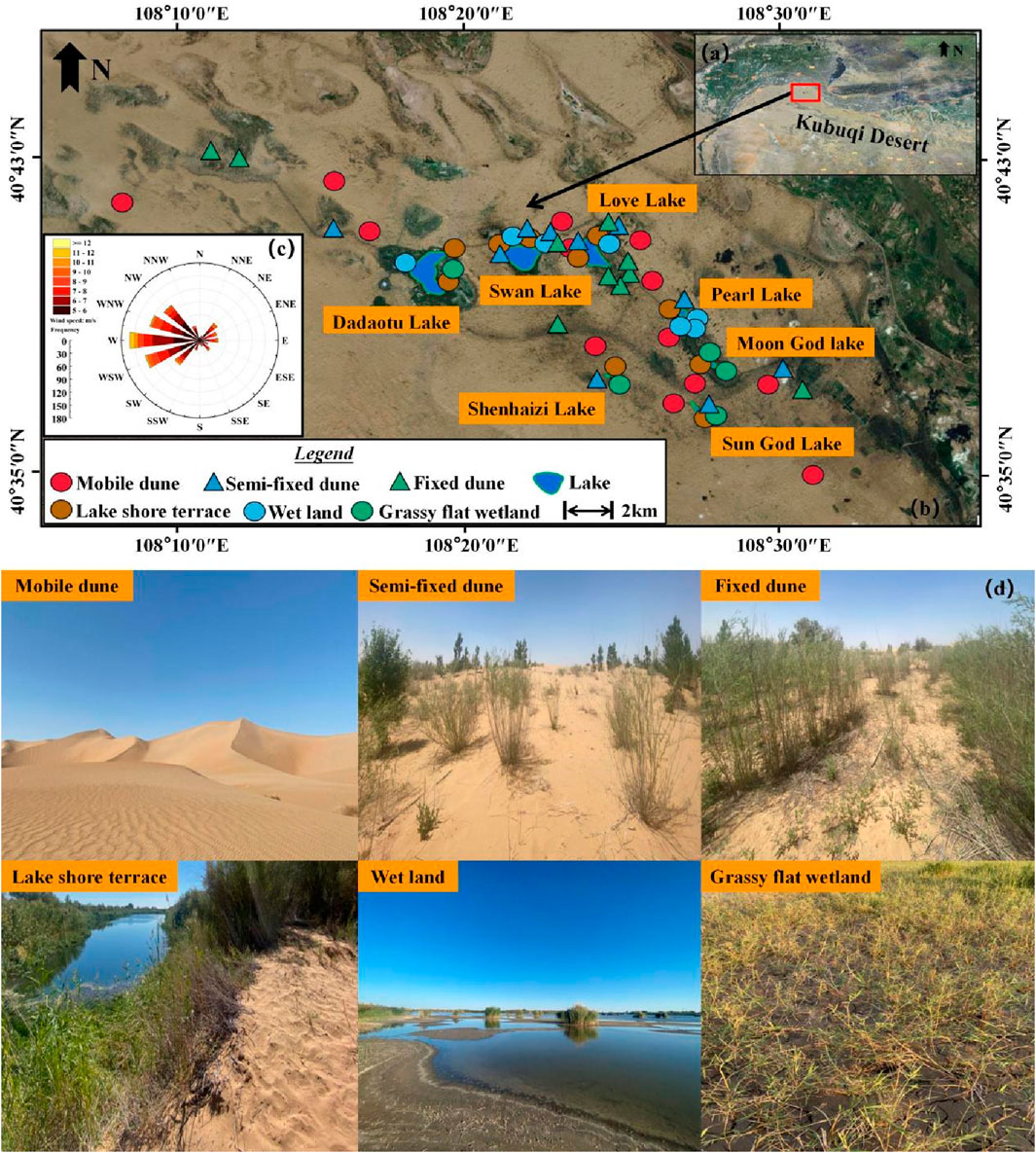
Figure 1. Geographic location of the study area and sample points. (A) Shows the geographic location of the study area, (B) shows a localized satellite photo of the Qixing Lake area, (C) shows the wind-dynamic background of the Qixing Lake area in the Kubuqi Desert, (D) shows photographs of six landform types.
The core of the study area is located at 40°36′30.40″-40°43′28.59″N, 108°16′45.47″-108°28′58.59″E, which is in the transition zone of arid and semi-arid areas, with low rainfall and sandy winds in the spring, the average annual precipitation of 250 mm, the prevailing wind direction for the west wind, northwest wind, the average annual wind speed of 3.5 m s-1, the maximum instantaneous wind speed of up to 24 m s-1, the wind period is concentrated in January-May, November, and December. According to the topographic and geomorphic features of Qixing Lake and its surroundings in the Kubuqi Desert, six surface types, namely, Mobile dune (MD), Semi-fixed dune (SFD), Fixed dune (FD), Lakeshore terrace (LST), Wetland (WL), and Grassy flat wetland (GFW), were selected for sampling. The vegetation cover of different landform types were MD (0%), SFD (9%–12%), FD (21%–25%), LST (26%–28%), WL (30%–33%), and GFW (45%–50%).
Sampling was carried out in late May 2023 based on an indoor experimental design. For the above six surface types, an area of about 2 km × 2 km was set for sampling for each surface type, and a total of 55 sampling areas were designed, as shown in Figure 1A. The five-point sampling method was used in each area to sample the center point and four vertices of the sample area, and a total of 275 samples were taken (MD65, SFD60, FD50, LST50, WL35, GFW25). The sampling method was similar to the sampling criteria used by Lancaster (1981) in the Namib Desert, where a 0.2 m × 0.2 m sand surface was selected and sampled at a depth of 0–10 cm with a weight of about 1,000 g–1500 g. Uniform specifications were used for sampling: Mobile dunes (sampled dune height <5.0 m) were evenly sampled from the top of the dune. Semi-fixed and Fixed dunes were sampled from flat areas with no vegetation cover, and the other surfaces were sampled from the areas with 0–2 cm of dead debris and weeds removed from the ground surface, and all the sampled samples were brought back to the laboratory in numbered, self-sealing bags for the indoor tests.
3.2 Particle size determination and analytical methods
The measurement of sediment particle size was done in the Key Laboratory of Aeolian Sand Physics and Sand Control Engineering, College of Desert Science and Engineering, Inner Mongolia Agricultural University. The volume fraction of the sample size was measured directly with the Mastersizer 3,000 laser particle size tester (measuring range of 0.01–3500 μm, shading of 5%–15%) of Malvern company (Shanghai, China), and the measurement was repeated three times for each sample to take the average value.
The particle size was classified using the Udden-Wentworth criterion, and transformed using the krumbein equation (Krumbein, 1934):
Where D is particle diameter (mm).
The formula proposed by Folk and Ward was used to calculate the particle size characteristic parameters (Folk and Ward, 1957).
Mean particle size (MZ) represents the average distribution of sand particle size and reflects the average kinetic energy of sand flow.
The sorting coefficient (
Skewness (SKG) represents the degree of symmetry of curve and reflects the symmetry of distribution of sand particle size. The skewness of normal distribution is 0, positive skewness indicates more fine particles, and negative skewness indicates more coarse particles.
Kurtosis (KG) reflects the concentration degree of sand particle size. The larger the kurtosis, the higher the peak value of sand particle size and the higher the concentration degree of average particle size range.
Skewness and kurtosis are visual reflections of the symmetry and sharpness of the frequency curve. Skewness reflects the symmetry of the particle size distribution and also indicates the relative position of the mean and median. If it is negatively biased, the frequency curve will have a thick tail with the mean located thicker than the median, and if it is positively biased, the frequency curve will have a thin tail with the mean located thinner than the median. Kurtosis is a measure of the ratio of the middle and tail spreads of a particle size distribution. In order to elucidate the grain size differences and regional patterns of change between different types of surface sediments, the experiments in this paper averaged the grain size parameters for the same surface type, and the intra-group data variability is reflected in the figure in the form of error bars (statistical standard deviation).
4 Results
4.1 Particle size distribution parameters of different surface types of sediments
4.1.1 Main parameters of particle size
The differences in grain size parameters of different types of surface sediments are shown in Figure 2. The mean particle size of surface sediments around Qixing Lake ranged from medium sand to clay (1.68
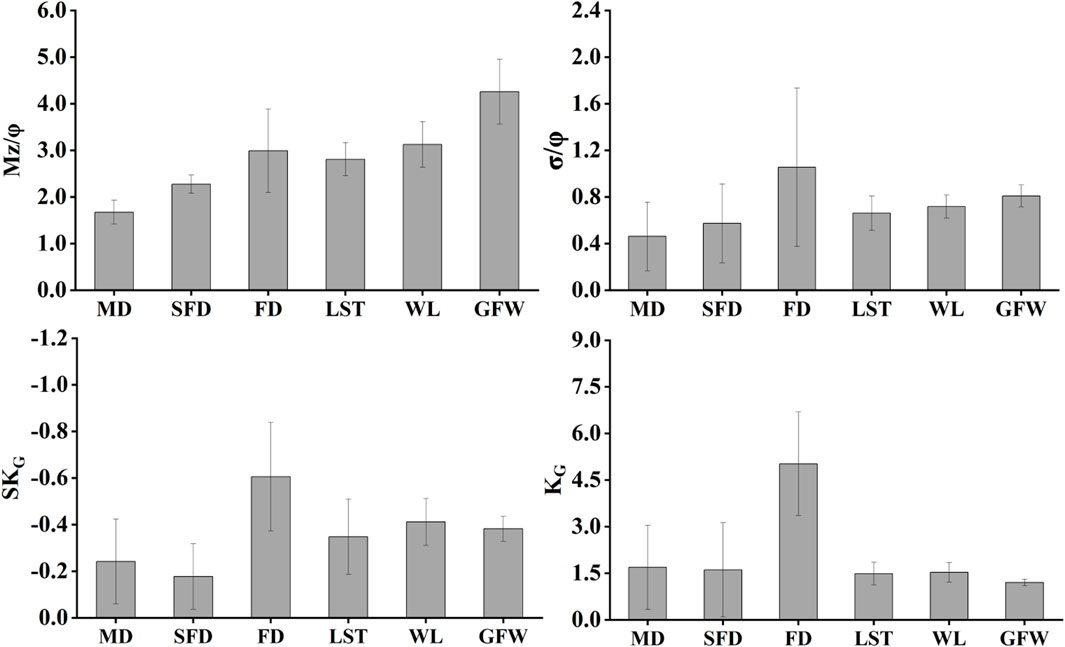
Figure 2. The mean particle size, sorting coefficient, Skewness and kurtosis of different types of surface sediments. Note: Mobile dune (MD), Semi-fixed dune (SFD), Fixed dune (FD), Lakeshore terrace (LST), Wetland (WL), and Grassy flat wetland (GFW).
The skewness values ranged from −0.61 to −0.18, and the frequency of occurrence of the various skewnesses varied, but all were negatively skewed distributions. This indicates that most of the distribution curves for surface sediments have a thick tail, which suggests that the mean particle size has a value greater than the median. Similarly, the negatively skewed distribution of different types of surface sediment grain size is reflected in the kurtosis. The presence of thick tails in the particle size distribution makes the frequency curve tend to be thin and narrow due to the shortening of the tails, resulting in large kurtosis values. The mean values of kurtosis of different types of surface sediments ranged from 1.20 to 5.02, and the flattening of the frequency curves was narrow or very narrow. From the statistical results, all types were dominated by very narrow to very narrow grain size distributions, except for the GFW and LST surface sediments, which were narrow.
4.1.2 Relationship between particle size parameters
The correlations between individual grain size parameters of different surface types of sediments around Qixing Lake are more complex. As shown in Figure 3, the sorting coefficient of fixed dune was negatively correlated with the φ-value of the mean particle size (y = −0.57x + 2.76, R2 = 0.57), grassy flat wetland showed a positive correlation (y = 0.11x + 0.332, R2 = 0.69), and the correlation of the remaining surface types was not significant; as for the correlation between skewness and the mean particle size, the mobile dune showed a positive trend with the φ-value of the mean particle size (y = 0.51x - 1.09, R2 = 0.53), the skewness of fixed dune and lakeshore terrace were negatively correlated (FD:y = −0.22x + 0.04, R2 = 0.70; LST:y = −0.40x + 0.79, R2 = 0.78), and the correlation for the rest of the surface types was not significant. The mean particle size of kurtosis of fixed dune and grassy flat wetland were negatively correlated with the φ-value of mean particle size (FD:y = −3.38x + 7.36, R2 = 0.42; GFW:y = −0.14x +1.80, R2 = 0.85), and the correlation was not significant for the remaining surface types.
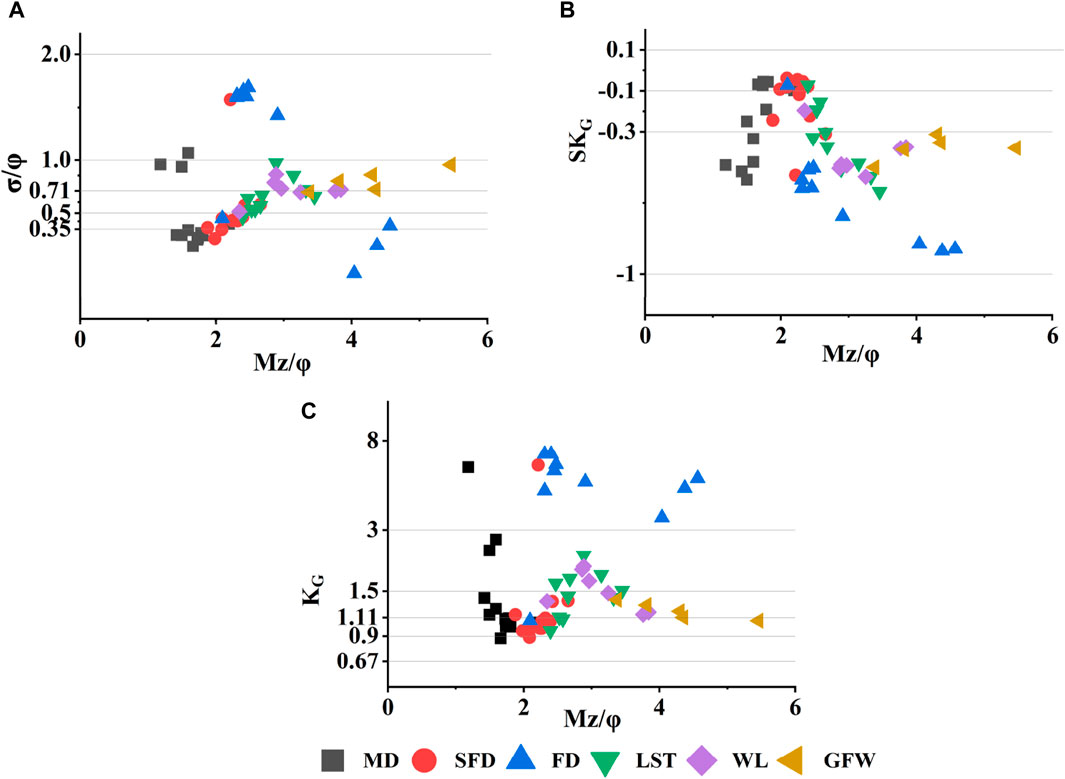
Figure 3. Scatter plot between particle size parameters. (A) Is the relationship between the mean particle size (MZ) and the sorting coefficient (
4.2 Forms of distribution of sediment grain size in different surface types
4.2.1 Grain size content
The grain size composition of the soils of the different surface types in the study area is shown in Table 1. For the mobile dune, the dominant grain size was medium sand (51.74%), followed by fine and coarse sand, which together amounted to 44.60% by weight. The highest surface content of SFD was fine sand (48.64%), followed by medium sand (43.25%). The highest surface content of fixed dune was fine sand (53.07%), followed by medium sand (34.19%), which became finer than SFD, and the content of clayey grains in fixed dune was significantly increased, which accounted for the highest percentage of all surface types. The highest content in the LST was still fine sand (54.69%), followed by medium sand (25%), and then very fine sand and silt. The content of each grain size in the WL was similar to that of the lakeshore terrace. The dominant grain size in GFW is silt, but the content of silt, very fine sand, and fine sand has no obvious single-peak pattern, the dominant grain size is not obvious, and the three kinds of grain fractions account for a relatively uniform, indicating that the depositional environment is more complex, or more affected by the material in the source area.
Medium sand is the most significant variation in different surface types. As the degree of surface restoration becomes higher, the content of medium sand is lower; the second significant grain size is silt, which is opposite to the change rule of medium sand content, the higher the degree of surface restoration, the higher the content of silt. Extremely coarse sand is absent from all surface types.
From the triangulation of the grain size composition of the sediments from each surface type (Figure 4), the sand fraction (>500 μm) was basically uninvolved in all surface types except for the mobile dune as well as the individual sample sites with semi-fixed dune, and the sand fraction was the lowest among the five surface types. The overall proportion of different surface types in the grain size smaller than the medium sand fraction (<250 μm) was MD < SFD < FD < FD < WL < GFW, with average contents of 26.21%, 55.76%, 65.81%, 74.87%, 79.90%, and 95.04%, respectively. The proportion of medium sand in the different surface types follows the opposite pattern to the proportion of silt.
4.2.2 Cumulative probability profile
As shown in Figure 5, The peak range of the plurality of grain size volume fractions of the fixed dune was in the range of 285–634 μm, with large fluctuations and an overall coarseness. The interval of the peak of the SFD is in the range of 258–425 μm, which is more concentrated than the fixed dune; The peak intervals of FD, LST, WL, and GFW were gradually stabilized at 191–285 μm, 170–261 μm, 153–234 μm, and 64–189 μm, respectively, and the plurality of grain sizes gradually became smaller. Some samples from MD, SFD, and FD showed bimodal patterns with fluctuations of 0.3%–1.1% at 3–14 μm (cumulative percentage of 3.76%), 0.7–2.15 μm (4.12%), and 1.07–4.32 μm (15.71%), respectively, while LST, WL and GFW showed a single-peaked pattern as a whole.
Cumulative frequency curves reveal the relationship between sediment transport mode and particle size distribution. As shown in Figure 6, the average probability cumulative curve for each type clearly consists of two segments, representing the saltation component and the suspended component, respectively, with the creep component missing. The intercepts of the saltation component and suspended component are located in the range of 2–5.79
The probabilistic cumulative curves of sediments from different surfaces show a bipartite pattern, and the content of the saltation component is higher than that of the suspended component, which can account for nearly 80%–95% of the whole sample. Among them, mobile dune and semi-fixed dune have the largest share of saltation component, which is stable at about 95%, and individual sample points can reach 99%. FD’s saltation component starts to decrease compared to MD and SFD, and the probability cumulative curve change rule of the three surface types of LST, WL, and GFW are approximately the same; the percentage of the saltation component of grassy flat wetland and lakeshore terrace are not much different, and it can be about 80%.
5 Discussion
5.1 Trends and causes of changes in sediment grain size characteristics
There is some variation in the composition of the surface material for different deserts and different surface types, but the grain size of the sand material in most deserts is fine to medium sand, with excellent to moderate sorting (Li et al., 2019; Zhang et al., 2021). The mean particle size of surface sediments was between clay and medium sand; the dune samples were coarser than in other deserts (Zhang et al., 2015; Wang et al., 2003); surface types near the lake had finer grain sizes than those away from the lake; and the content of clayey and medium sand fractions increased significantly with an increase in plant cover. At the same time, the sampled area of fixed dune is located at the influence of the main wind direction, with a small degree of anthropogenic interference and no vegetation growth. With the constant action of wind, this resulted in the gradual loss of fine particle components in the fixed dune, making the saltation component greater.
The reasons for the differences in the grain size distribution of different types of surface sediments are, in the case of dunes, mainly due to the transport and accumulation of sand particles by wind erosion. Under the influence of frequent and strong erosive winds, the fine-grained material of the soil is easily transported away from its original position under the action of wind-sand flow, which makes the content of sandy material in the soil elevated. For areas close to lakes, where water is more plentiful, the transport and accumulation of sandy material is altered by the supply of material and vegetation during the formation of the surface, and the soil granularity develops in the direction of refinement. The particle size characteristics of surface sediments in deserts are affected by the combined effects of source area material and wind sorting, and an adequate sorting process can effectively increase the degree of wind-formed sand sorting and reduce the
The different surface skewnesses around Qixing Lake are concentrated in negative to very negative skewness, and the kurtosis is concentrated in narrow to very narrow. As shown in Figure 7, except for the fixed dune, the other surfaces are mostly concentrated in the better sorted low peak state area, and the distribution of point clusters of MD, SFD, LST, WL, and GFW around the lake is very obvious, and the boundaries of the point clusters are still more obvious, although there is a spatial differentiation of the values of the grain size parameter of the fixed dune.
It has been suggested that the reason for differences in skewness of different types of sediments is related to the mode of transport deposition in different geomorphic sites (Pan et al., 2015). Once detached, fine-grained material, is transported with the airflow for a long period of time and on a large scale in suspension, it can be inferred that there is a positive skewness and a very positive skewness in the surface sediments of the flowing dunes (fine tails). The samples in this paper all exhibit negative skewness, as a result of the deposition of suspended material. In the distribution of probability cumulative curves for different types of surface sediments, the share of fine-grained materials that are easily transported, the suspended component shown in Figure 6, ranged from 6.71% to 12.73% in MD, SFD, and FD surface depositional environments, with an average of 9.47%, while in LST, WL, and GFW, the contribution ranged from 19.36% to 23.61%, with an average of 21.07%, contributing more than twice the percentage. From the analysis of the main form of wind-sand flow movement (saltation process), sand dunes are negatively biased due to wind acceleration along the slope and erosion of surface material, and the transport of fine-grained material makes the surface constituent material coarser than the original state. In addition, on the leeward slopes of dunes, sand particles crossing the top of the dune become supersaturated by localized wind-sand flows due to deceleration of the airflow separation and reverse eddy currents, and are subsequently deposited and sloughed off on the leeward slopes, which adds a coarser component to the fine-grained material on the leeward slopes. In areas with high vegetation cover, high degree of anthropogenic influence, and good ecological restoration, sand particles will gradually accumulate after being subjected to the blocking effect, which is also the reason for the negative bias phenomenon.
5.2 Relationship between depositional environment and particle size
It has been shown that coarse and very coarse sand (−1 to 1
Numerous studies have confirmed that the particle size distribution of sediments is usually not a simple lognormal distribution, but has two or three lognormal components, each with a different mean particle size and sorting coefficient. In this paper, MD, SFD, and FD showed asymmetric bimodal patterns, with more obvious main peaks and lower secondary peaks; LST, WL, and GFW showed overall unimodal patterns, and the peaks decreased with the increase of vegetation cover. This relationship described above is expressed on the cumulative probability curve as two or three lines with different slopes. Visher (1969) was the first to use probabilistic cumulative curves to reveal the relationship between sediment transport mode and grain size distribution, from which the depositional environments in which the features were formed could be inferred. Existing research results show that for wind-formed sediments, the probability accumulation curve generally exists with one to three cutoff points, and the grain size distribution can be divided into two to four mutually independent line segments. The more frequent and intense the wind-sand activity, the steeper the characteristics of the curve (Liu et al., 2014), which is consistent with the findings of this paper. The same surface type is essentially two line segments, with the steepest slope for the mobile dune saltation component and a gradual flattening of the other surfaces by increasing environmental disturbance. Combined with the analysis in this paper, it was found that mobile, semi-fixed, and fixed dunes are not the main contributing surface types of suspended material, which can provide some data support for the subsequent dust production model of desert-lake landscapes.
Comprehensive results of sediment grain size characterization of different depositional environments of Qixing Lake show that the parameter combination characteristics and the graphical interpretation of the particle size characteristics can be effective in distinguishing the sediments with different sedimentary origin, which can provide a reference basis for future research on the depositional environment of the Kubuqi Desert-lake sediments.
6 Conclusion
Surface sediments around Qixing Lake are mainly composed of medium and fine sands. The grain size of sand material in the grassy flat wetland is the finest (4.26
The dominant grain size in mobile dune was medium sand (51.74%), while fine sand (51.15%) was found in semi-fixed dune, fixed dune, lakeshore terrace, and wetland. In grassy flat wetland no grain size was dominant. Vegetation cover and anthropogenic disturbance measures altered sediment transport deposition patterns, with medium sands the most sensitive, followed by fines.
Sediment characteristics of the surface around Qixing Lake are indicative of biased results of the grain-size pattern, and the transport of suspended material can contribute to the negative bias phenomenon, as evidenced by the presence of point-cluster clustering zoning boundaries in the three-dimensional characterization of the grain-size parameters.
The differentiation pattern of the saltation component and suspended component of the surface sediments around Qixing Lake is characterized by a two-stage pattern. The contribution of suspended components in the lakeshore terrace, wetland, and grassy flat wetland (total average 21.07%) accounted for more than twice as much as that in the mobile, semi-fixed, and fixed dunes (total average 9.47%), which demonstrated that the mobile, semi-fixed, and fixed dunes were not the main contributing surface types of suspended material in the Qixing Lake area.
Data availability statement
The original contributions presented in the study are included in the article/Supplementary Material, further inquiries can be directed to the corresponding author.
Author contributions
CX: Investigation, Methodology, Writing–original draft. HZ: Data curation, Formal Analysis, Writing–review and editing. MY: Investigation, Supervision, Writing–review and editing. YY: Formal Analysis, Writing–review and editing.
Funding
The author(s) declare that financial support was received for the research, authorship, and/or publication of this article. This work was supported by the “Science and Technology revitalize Mongolia” action Key special Project -Study on ecological protection and control technology of Kubuqi Desert (No. KJXM-EEDS-202006), Scientific Research Initiation Program for Introducing Excellent Talents in Inner Mongolia Autonomous Region (2022), Desert sand ecological protection and management technology innovation team (NMGIRT2408) and the Inner Mongolia Agricultural University High-level Talent Introduction Scientific Research Launch Project (No. NDYB 2020-7).
Conflict of interest
The authors declare that the research was conducted in the absence of any commercial or financial relationships that could be construed as a potential conflict of interest.
Publisher’s note
All claims expressed in this article are solely those of the authors and do not necessarily represent those of their affiliated organizations, or those of the publisher, the editors and the reviewers. Any product that may be evaluated in this article, or claim that may be made by its manufacturer, is not guaranteed or endorsed by the publisher.
References
Cai, J. L., Meng, Z. J., Meng, R. B., Li, H. N., Chen, X. Y., Ren, X. M., et al. (2024). Exploring a path of vegetation restoration best suited for a photovoltaic plant in the Hobq desert. Front. Environ. Sci. 12. doi:10.3389/fenvs.2024.1380421
Campmans, G. H. P., and Wijnberg, K. M. (2022). Modelling the vertical grain size sorting process in aeolian sediment transport using the discrete element method. Aeolian Res. 57, 100817. doi:10.1016/j.aeolia.2022.100817
Cera, A., Pierdomenico, M., Sodo, A., and Scalici, M. (2022). Spatial distribution of microplastics in volcanic lake water and sediments: relationships with depth and sediment grain size. Sci. total Environ. 829, 154659. doi:10.1016/j.scitotenv.2022.154659
Folk, R. L., and Ward, W. C. (1957). Brazos River bar:a study in the significance of grain size parameters. J. Sediment. Petrology 27 (1), 3–26. doi:10.1306/74D70646-2B21-11D7-8648000102C1865D
Han, G. Z., Cao, G. C., Cao, S. K., Ye, W. Q., and Cheng, G. (2022). Effects of ecological restoration on the distribution of soil particles and organic carbon in alpine regions. Separations 9 (10), 279. doi:10.3390/separations9100279
Hereher, M. E. (2010). Sand movement patterns in the Western Desert of Egypt: an environmental concern. Environ. Earth Sci. 59 (5), 1119–1127. doi:10.1007/s12665-009-0102-9
Ijzendoorn, C. O., Hallin, C., Cohn, N., Reniers, A. J., and De Vries, S. (2023). Novel sediment sampling method provides new insights into vertical grain size variability due to marine and aeolian beach processes. Earth Surf. Process. Landforms 48 (4), 782–800. doi:10.1002/esp.5518
Jiang, H., Dun, H., Tong, D., and Huang, N. (2017). Sand transportation and reverse patterns over leeward face of sand dune. Geomorphology 283, 41–47. doi:10.1016/j.geomorph.2016.12.030
Jung, H. S., Lim, D., Xu, Z. K., Kim, J. H., Lee, J. H., and Jeong, D. Y. (2021). Zoning of coastal environments based on sediment textural and geochemical characteristics and their major oceanographic constraints: a case study in South Korea. J. Asian Earth Sci. 218, 104883. doi:10.1016/j.jseaes.2021.104883
Karimi, A., Khormali, F., and Wang, X. (2017). Discrimination of sand dunes and loess deposits using grain-size analysis in northeastern Iran. Arabian J. Geosciences 10 (12), 275. doi:10.1007/s12517-017-3058-1
Kasper-Zubillaga, J. J., Arellano-Torres, E., Álvarez-Sánchez, L. F., Carlos, D. L., Martínez-Serrano, R. G., and Baltazar-Jiménez, P. A. E. (2022). Implications of polymodal distributions in the grain size parameters of coastal dune sands (Oaxaca, Mexico). Sediment. Geol. 437, 106189. doi:10.1016/j.sedgeo.2022.106189
Kok, J. F., Parteli, R. J. E., Michaels, I. T., and Karam, B. D. (2012). The physics of wind-blown sand and dust. Rep. Prog. Phys. 75 (10), 106901. doi:10.1088/0034-4885/75/10/106901
Kok, J. F., and Renno, N. O. (2009). A comprehensive numerical model of steady state saltation (COMSALT). J. Geophys. Res. Atmos. 114 (D17). doi:10.1029/2009JD011702
Krumbein, W. C. (1934). Size frequency distribution of sediments. J. Sediment. Res. 4 (2), 65–77. doi:10.1306/D4268EB9-2B26-11D7-8648000102C1865D
Lancaster, N. (1981). Grain size characteristics of Namib Desert linear dunes. Sedimentology 28 (1), 115–122. doi:10.1111/j.1365-3091.1981.tb01668.x
Li, J., and Ravi, S. (2018). Interactions among hydrological-aeolian processes and vegetation determine grain-size distribution of sediments in a semi-arid coppice dune (nebkha) system. J. Arid Environ. 154, 24–33. doi:10.1016/j.jaridenv.2018.03.011
Li, J. C., Yao, Q., Wang, Y., Liu, R. T., and Zhang, H. (2019). Grain-size characteristics of surface sediments of nebkhas at the southern margin of the Mu Us dune field, China. Catena 183, 104210. doi:10.1016/j.catena.2019.104210
Li, Y. S., Jia, X. P., Wang, H. B., and Ma, Q. M. (2023). Desert river channel deposition characteristics and their implications for lateral infusion of aeolian sand in the Ulan Buh desert reaches of the Yellow River. Environ. Earth Sci. 82 (22), 525. doi:10.1007/s12665-023-11224-3
Lin, Y. C., Mu, G. J., and Xu, L. S. (2022). Grain size and sedimentary sorting characteristics of atmospheric dust in the cele oasis, southern margin of taklimakan desert. Sustainability 14 (13), 8093. doi:10.3390/su14138093
Liu, B. L., Qu, J. J., Ning, D. H., Gao, Y. H., Zu, R. P., and An, Z. S. (2014). Grain-size study of aeolian sediments found east of Kumtagh Desert. Aeolian Res. 13, 1–6. doi:10.1016/j.aeolia.2014.01.001
Liu, D. W., Bertrand, S., and Weltje, G. J. (2019). An empirical method to predict sediment grain size from inorganic geochemical measurements. Geochem. Geophys. Geosystems 20 (7), 3690–3704. doi:10.1029/2018GC008154
Liu, J. B., Zhang, P., and Gao, Y. (2023). Effects of vegetation rehabilitation on soil inorganic carbon in deserts: a meta-analysis. Catena 231, 107290. doi:10.1016/j.catena.2023.107290
Lopez, M. O., Hegy, C. M., and Missimer, M. T. (2020). Statistical comparisons of grain size characteristics, hydraulic conductivity, and porosity of barchan desert dunes to coastal dunes. Aeolian Res. 43, 100576. doi:10.1016/j.aeolia.2020.100576
Ma, Y., Cheng, X. Q., Kang, F. F., and Han, H. R. (2022). Dynamic characteristics of soil aggregate stability and related carbon and nitrogen pools at different developmental stages of plantations in northern China. J. Environ. Manag. 316, 115283. doi:10.1016/j.jenvman.2022.115283
Owen, P. R. (1964). Saltation of uniform grains in air. J. Fluid Mech. 20 (2), 225–242. doi:10.1017/S0022112064001173
Pan, B. T., Pang, H. L., Zhang, D., Guan, Q. Y., Wang, L., Li, F. Q., et al. (2015). Sediment grain-size characteristics and its source implication in the Ningxia–Inner Mongolia sections on the upper reaches of the Yellow River. Geomorphology 246, 255–262. doi:10.1016/j.geomorph.2015.06.028
Peng, J., Zhao, H., Dong, Z. B., Zhang, Z. C., Yang, H. Y., and Wang, X. L. (2022). Numerical methodologies and tools for efficient and flexible unmixing of single-sample grain-size distributions: application to late Quaternary aeolian sediments from the desert-loess transition zone of the Tengger Desert. Sediment. Geol. 438, 106211. doi:10.1016/j.sedgeo.2022.106211
Purkait, B. (2010). The use of grain-size distribution patterns to elucidate aeolian processes on a transverse dune of Thar Desert, India. Earth Surf. Process. Landforms 35 (5), 525–530. doi:10.1002/esp.1939
Qi, S., Ren, X. M., Dang, X. H., and Meng, Z. J. (2023). Mechanisms of dust emissions from lakes during different drying stages in a semi-arid grassland in northern China. Front. Environ. Sci. 10, 1110679. doi:10.3389/fenvs.2022.1110679
Roehner, C., Pierce, J. L., and Yager, E. M. (2020). Spatial and temporal changes in aeolian redistribution of sediments and nutrients following fire. Earth Surf. Process. Landforms 45 (11), 2556–2571. doi:10.1002/esp.4913
Sandler, A., Zaid, M., and Stein, M. (2023). From desert dust to ongoing soil formation in the mountainous areas of the south Levant. Catena 233, 107506. doi:10.1016/j.catena.2023.107506
Shao, Y., and Li, A. (1999). Numerical modelling of saltation in the atmospheric surface layer. Boundary-Layer Meteorol. 91, 199–225. doi:10.1023/A:1001816013475
Song, Y. G., Chen, X. L., Li, Y., Fan, Y. F., and Collins, A. L. (2022). Quantifying the provenance of dune sediments in the Taklimakan Desert using machine learning, multidimensional scaling and sediment source fingerprinting. Catena 210, 105902. doi:10.1016/j.catena.2021.105902
Telfer, M. W., Gholami, H., Hesse, P. P., Fisher, A., and Hartley, R. (2020). Testing models of linear dune formation by provenance analysis with composite sediment fingerprints. Geomorphology 364, 107208. doi:10.1016/j.geomorph.2020.107208
Touré, A. A., Tidjani, A. D., Rajot, J. L., Marticorena, B., Bergametti, G., Bouet, C., et al. (2019). Dynamics of wind erosion and impact of vegetation cover and land use in the Sahel: a case study on sandy dunes in southeastern Niger. Catena 177, 272–285. doi:10.1016/j.catena.2019.02.011
Visher, G. S. (1969). Grain size distributions and depositional processes. J. Sediment. Res. 39 (3), 1074–1106. doi:10.1306/74D71D9D-2B21-11D7-8648000102C1865D
Wang, F. F., Yu, J., Liu, Z. J., Kong, M., and Wu, Y. F. (2021). Study on offshore seabed sediment classification based on particle size parameters using XGBoost algorithm. Comput. Geosci. 149, 104713. doi:10.1016/j.cageo.2021.104713
Wang, X. M., Dong, Z. B., Zhang, J. W., Qu, J. J., and Zhao, A. G. (2003). Grain size characteristics of dune sands in the central Taklimakan Sand Sea. Sediment. Geol. 161 (1-2), 1–14. doi:10.1016/S0037-0738(02)00380-9
Webb, N. P., LeGrand, S. L., Cooper, B. F., Courtright, E. M., Edwards, B. L., Felt, C., et al. (2021). Size distribution of mineral dust emissions from sparsely vegetated and supply-limited dryland soils. J. Geophys. Res. Atmos. 126 (22), e2021JD035478. doi:10.1029/2021JD035478
White, B. R., and Tsoar, H. (1998). Slope effect on saltation over a climbing sand dune. Geomorphology 22 (2), 159–180. doi:10.1016/S0169-555X(97)00058-5
Yang, X. P., Forman, S., Hu, F. G., Zhang, D. G., Liu, Z. T., and Li, H. W. (2016). Initial insights into the age and origin of the Kubuqi sand sea of northern China. Geomorphology 259, 30–39. doi:10.1016/j.geomorph.2016.02.004
Zhang, Z. C., Dong, Z. B., and Li, J. Y. (2015). Grain-size characteristics of dune networks in China's tengger desert. Geogr. Ann. Ser. A, Phys. Geogr. 97 (4), 681–693. doi:10.1111/geoa.12108
Zhang, Z. C., Liang, A. M., Zhang, C. X., and Dong, Z. B. (2021). Gobi deposits play a significant role as sand sources for dunes in the Badain Jaran Desert, Northwest China. Catena 206, 105530. doi:10.1016/j.catena.2021.105530
Zhou, N., Li, Q., Zhang, C. L., Huang, C. H., Wu, Y. B., Zhu, B. Q., et al. (2021). Grain size characteristics of aeolian sands and their implications for the aeolian dynamics of dunefields within a river valley on the southern Tibet Plateau: a case study from the Yarlung Zangbo river valley. Catena 196, 104794. doi:10.1016/j.catena.2020.104794
Keywords: Kubuqi Desert, Qixing Lake, particle size parameter, particle size distribution patterns, sediment movement regime
Citation: Xi C, Zuo H, Yan M and Yan Y (2024) Grain size characteristics of different types of surface sediments around Qixing Lake in Kubuqi Desert. Front. Environ. Sci. 12:1409260. doi: 10.3389/fenvs.2024.1409260
Received: 29 March 2024; Accepted: 17 June 2024;
Published: 05 July 2024.
Edited by:
Kanat Samarkhanov, Nazarbayev University, KazakhstanReviewed by:
Zhengcai Zhang, Northwest Institute of Eco-Environment and Resources (CAS), ChinaHongchao Dun, Lanzhou University, China
Copyright © 2024 Xi, Zuo, Yan and Yan. This is an open-access article distributed under the terms of the Creative Commons Attribution License (CC BY). The use, distribution or reproduction in other forums is permitted, provided the original author(s) and the copyright owner(s) are credited and that the original publication in this journal is cited, in accordance with accepted academic practice. No use, distribution or reproduction is permitted which does not comply with these terms.
*Correspondence: Min Yan, eW01MjMzQDEyNi5jb20=
 Cheng Xi1
Cheng Xi1 Hejun Zuo
Hejun Zuo Min Yan
Min Yan
